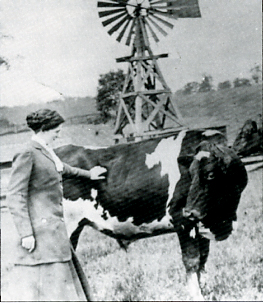
Click Here to Return to Milestones
The recent passing of Clyde Piquet leaves a vacuum in the hearts of those who knew him. A great man and a great historian, he will be much missed. Shortly before his death, he gave me this little story and a picture about windmills. I think it is a fitting tribute to Clyde. For like a windmill, he stood high and saw the historical landscape of this county. And like a windmill, he brought forth the fresh water of historical interest.---CW Townsend
Nowadays it's an isolated farm indeed that
doesn't have electricity. It lights the houses and barns and runs
the washing machine and vacuum cleaner and refrigerator and freezer,
pumps the water and does many other jobs. Certainly its advent
was a boon to farmers, but it sounded the death knell for that
most picturesque structure once so familiar on the country landscape-the
windmill.
Windmills have been known for thousands of years. Holland, for
instance, could hardly have come into existence without them.
These, however, were the old-type mills with huge canvas sails
and were used not only for pumping water but also for sawing wood
and grinding grain. (Remember that contented miller who lived
on the Dee and envied nobody and nobody envied him?)
It was in the 1880s that the newer-type windmill was invented.
At first it was made mostly of wood, but a few years later someone
started using iron parts, which increased its efficiency and life
span so that one would often last fifty or sixty years.
The windmill consisted of a tall iron scaffold, something like
the modern television tower. On top of this was a square platform
and mounted above the platform was a huge wheel with its myriad
blades and its fan-shaped tail which kept the wheel headed into
the wind. A long shaft reached from the wheel to the pump; and
as the wind revolved the wheel, the shaft, by means of gears,
worked the pump.

And when the wind blew and the wheel revolved, it squeaked and
creaked and the pump made a jangling noise, but it was all part
of a rural symphony which is rarely heard anymore.
The water was conducted to its destination by means of long pipes.
There were the tanks in the milk house which must be kept full
of icy cold water to cool huge cans of milk. And there were the
watering tanks in the barns and barn yards which must also be
kept full of fresh water so the stock could quench their thirst.
Sometimes you could keep a few fish or even a turtle in one of
the tanks, and it was fun to hold your hands under the end on
the pipe and let the cold water run between your fingers. Or you
might try getting a drink and get your face plentifully splashed
with water.
Windmills very seldom needed repairs, but there was an iron ladder
built into one corner of the scaffold just in case you did need
to get up to the platform. It did make a good vantage point from
which to spot any stock which had strayed away.
And last, but not least, it was an irresistible temptation to
Junior. Children were absolutely forbidden to climb the windmill.
But children couldn't resist the temptation, at least once. Junior
probably made it to the platform, but sister usually lost her
nerve about halfway up. Even from that distance the ground looked
awfully far away. Being a girl, she could retreat without losing
caste, and then she could get revenge on brother by running to
her parents and informing them that Junior was on top of the windmill.